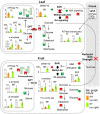Gene regulatory networks elucidating huanglongbing disease mechanisms
- PMID: 24086326
- PMCID: PMC3783430
- DOI: 10.1371/journal.pone.0074256
Gene regulatory networks elucidating huanglongbing disease mechanisms
Abstract
Next-generation sequencing was exploited to gain deeper insight into the response to infection by Candidatus liberibacter asiaticus (CaLas), especially the immune disregulation and metabolic dysfunction caused by source-sink disruption. Previous fruit transcriptome data were compared with additional RNA-Seq data in three tissues: immature fruit, and young and mature leaves. Four categories of orchard trees were studied: symptomatic, asymptomatic, apparently healthy, and healthy. Principal component analysis found distinct expression patterns between immature and mature fruits and leaf samples for all four categories of trees. A predicted protein - protein interaction network identified HLB-regulated genes for sugar transporters playing key roles in the overall plant responses. Gene set and pathway enrichment analyses highlight the role of sucrose and starch metabolism in disease symptom development in all tissues. HLB-regulated genes (glucose-phosphate-transporter, invertase, starch-related genes) would likely determine the source-sink relationship disruption. In infected leaves, transcriptomic changes were observed for light reactions genes (downregulation), sucrose metabolism (upregulation), and starch biosynthesis (upregulation). In parallel, symptomatic fruits over-expressed genes involved in photosynthesis, sucrose and raffinose metabolism, and downregulated starch biosynthesis. We visualized gene networks between tissues inducing a source-sink shift. CaLas alters the hormone crosstalk, resulting in weak and ineffective tissue-specific plant immune responses necessary for bacterial clearance. Accordingly, expression of WRKYs (including WRKY70) was higher in fruits than in leaves. Systemic acquired responses were inadequately activated in young leaves, generally considered the sites where most new infections occur.
Conflict of interest statement
Figures





References
-
- Bove JM (2006) Huanglongbing: A destructive, newly-emerging, century-old disease of citrus. J Plant Pathol 88: 7–37.
-
- Folimonova SY, Robertson CJ, Garnsey SM, Gowda S, Dawson WO (2009) Examination of the Responses of Different Genotypes of Citrus to Huanglongbing (Citrus Greening) Under Different Conditions. Phytopathology 99: 1346–1354. - PubMed
-
- Albrecht U, Bowman KD (2011) Tolerance of the Trifoliate Citrus Hybrid US-897 (Citrus reticulata Blanco × Poncirus trifoliata L. Raf.) to Huanglongbing. Hortscience 46: 16–22.
-
- Albrecht U, Bowman KD (2012) Transcriptional response of susceptible and tolerant citrus to infection with Candidatus Liberibacter asiaticus. Plant Sci 185: 118–130. - PubMed
-
- Folimonova SY, Achor DS (2010) Early Events of Citrus Greening (Huanglongbing) Disease Development at the Ultrastructural Level. Phytopathology 100: 949–958. - PubMed
Publication types
MeSH terms
LinkOut - more resources
Full Text Sources
Other Literature Sources

